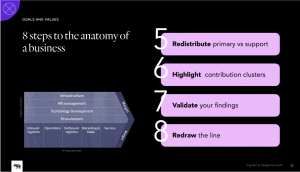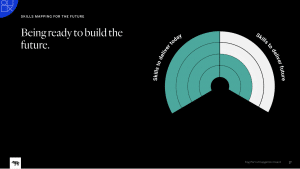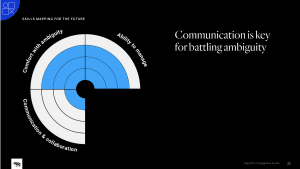Day 1- Do More With Less: Equip and Lead DesignOps Through Adversity

— Welcome from London and today we are talking about sentence of “Doing more with less”
-
Companies want to be lean and more efficient and agile
-
Under adversity, pressure increases drastically and leads to tough decisions on team size, roles, and capabilities
— There are three tools we would like to share with you to have conversations in the future when change happens in your org

— To begin with will share MLK Jr’s quote that our survival remains on ability to be vigilant

— Change is a matter of when, not if, and is ongoing
-
Point we made here is to ask what we have learned with similar layoffs during the pandemic, which exceeded 2008 financial crisis
-
Previously we had a burst of hiring, and people promptly forgot about it
-
Two years we are back in same scenario, and have we prepared for it?
-

— The challenge has detrimental impact with loss of expertise, reduced capacity, and weakened team morale
-
Impact on work and product and services impacted
-
Impact beyond org and feeling it in community
-
We are fighting to prove our value
-

— We have three tools to prepare you times for ahead
-
Skill 1: Aligning on Goals and Values
-
Skill 2: Future Skills Mapping
-
Skill 3: Risk Planning with the Business
— Will share tools after the presentation

— So buckle up and get ready and will go through a lot of things, but you can dive into it later
— Align with goals and value
-
To be honest, we have to figure out what matters to the busienss and align our goals to do that
-
Imperative to show we are adding value to rest of business
-
If we show we are aiming at the same target, limits chances of negative impact of team when it arises
-
-
We will identify two frameworks

— First framework deals with the org culture itself
-
Goals and OKRs are visible, but less visible objectives are there as well
-
Understanding culture is important to see those hidden objectives
— Bonus of set-up questions is to ask yourself to figure out what org culture you have within your business
-
Won’t just be one culture, but there will be a predominant culture available
-
Once you see it, you can see invisible values business might have
-
i.e. Risk avoidance within a healthcare provider
-
-

— We are preaching to converted here, as DesignOps work is often invisible
-
It’s the glue that holds design and product org together
-
It takes two layers to penetrate though, to show value to business
— DesignOps is often cutoff as it is seen as cost-center and supporting activity, so we will intorduce second layer to work around cost cutting argument

— Porter’s Value chain is a framework to split activities between primary and secondary for a business
-
Will have definition of each activity in resources page and with examples to relate to

— Would recommend using framework in following way
-
As designers by craft or title, think of it as double-diagram
-
First four, broaden perspective, and second half narrow and redistribute focus

— First four steps as usual take on the design process
-
1: Stepping back and understanding the framework of value chain and definition of model
-
2: Identify players and SMEs within business and what happens in it
-
Find people who will tell you what you don’t know much about, and list out these activities in as detailed a way as possible
-
Don’t kill yourself doing this
-
-
3: Ask yourself for each of activities: Does it impact quality, feature, price, or customer experience?
-
4: Once answer this, analyze profitability and how it impacts bottom line

— You can then go to framework
-
5: Classify what is primary versus support. Primary as directed to what company directly provided.
-
6: Cluster activities between top contributing and bottom contributing, and enhance bottom processes and know top ones to focus on to link to internal priorities
-
7: Validate findings before finalizing the work
-
8: Once you see gap you ahve between activities and business objectives and value, connect that with your activities
-
No shortage with metrics like time-to-market, satisfaction rates, time spent on design tasks
-
Seeing which metrics on dotted line to connect directly to main business value
-
For difficult conversations, you will have hard metrics to link to business value
-
-

— Skills mapping is what we use for assessing team skills at a particular time
-
Can be used to deliver potential things in roadmap
— Strategic tool to leverage when things get more challenging

— First look at what to deliver today
-
Important to make sure you can deliver work, or deliver immediate needs
-
Being at risk of losing these skills, is major business risk
-
Make sure you can maintain what you are doing already
-

— Next focus on building the future, and have conversations with business to understand agreed roadmap
-
This will clarify what impact you can do with reduced teams or different skillsets

— Look at skills for resilience
- It means, what do we look at when things don’t go to plan?

— Comfort with ambiguity and change happens unexpectedly and cannot be as well planned as you hoped
-
Can fall into teams that can accept things aren’t going to plan
-
Providing sense and structure for ambiguity to others

— Look for ability to manage, as you shouldn’t manage everything yourself and make sure can’t take it all on yourself
-
Ability to support yourself and others in driving change

— Communication and collaboration is key and we do this day-to-day. Forget though, with ambiguity that people fill gaps in communications with their own anxieties
-
Being clear and upfront is key for supporting team

— Finally, comfort to approach adaptability if things change suddenly, very sudden for how things we used to work will change as well
-
Ways for working and collaborating and making shift is difficult
-
Can do prepatory work and embrace new ways to do things prior to shift

— Skills mapping about developing and having chance to grow and keep working, and go through challenging times

— Next will talk through risk planning and effectiveness for future

— Often don’t talk about this, as there are often teams for risk managmeent
-
Smaller orgs don’t have this, but often managed by ops or leadership team
— As DesignOps we can lean into this, and establish relationships, test scenarios, and make best of situations when we don’t go how we expect

— Created canvas for this and risk planning for future and will talk through key tools and topics

— First part is clarifying: What can go wrong?
-
Internet outages, mass illnesses, loss of major client for org
-
Start of useful conversation
-
-
Look at driving forces
-
Unlikely risk will happen on it’s own, but will have underlying driving forces and work out how to manage force rather than itself
-
Internet loss due to new internet provider
-
-
-
Call out unknowns and uncertainties
-
Calling out gaps in knowledge to capture questions you can ask yourselves later?
-
Knowing what questions to ask to stakeholder to keep an eye out for
-
-
-
Leading indicators
-
Risks can have leading indicator which you can spot earlier, as when scenario hits it’s much harder to respond to
-
Leading indicator let you catch what to look for and act quicker rather than big problem
-
-

— Then talk through possible impact
-
Cost, business, organizational
-
Impact for team day-to-day and be able to have conversation with business and keep eye out on teams and break into orders of impact
— Different orders of impact
-
First impact of what might happen from disruption (i.e. not paying invoices due to internet outage)
-
Second impact, or the knock-on effect of that first impact (i.e. can lead to additional charges due to late payments, accumulating technical debt)
-
Third order impact, (don’t go this far for more complex scenarios, but works for simple risks)

— Next do actions and responses, and what underlying drivers are and impact for figuring out responses to take and what can be done in response to impact, or underlying drivers and lead indicators
- If risk of losing Internet access, having 5G back-ups and being notified of upcoming changes

— Useful for hard conversations, and when not in the room
-
Helping business by understand risks, and you can be represented even when not in the room
-
Partners and stakeholders in business

— So we have presented tools and info to explore later
-
Here to take pressure off you for when times are difficult so you can support your team
-
Not just bureaucracy, but helping teams perform at best
-
Goal for tools to help you do this
-

— Thank you so much, and link to Figma file to download all of this, and feel free to reach out
FAQ
-
Risk planning framework to capitalize on learnings. Are there any scenarios we can shape through risk framework?
-
Depends on size of org, and who you can talk to, and responses to request.
-
Being able to start conversation is huge difference
-
Three tools presented, but goal is to be more prepared for different start-up conversations
-
-
How do you decide where to start? How to get buy-in for approaches?
-
Personally, order we put makes sense by slightly broader and grasping values of business and aligning self with it and understanding what business is looking for
-
Factor into risk planning for future and take one step back and skill mapping
-
First thing is to do, is go and reach out, as businesses don’t grasp how teams work and impact a change can have on those teams
-
By finding common language and starting conversations can make a huge difference
-
-

